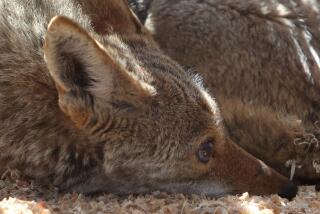North America’s first dogs were domesticated in Siberia, but their descendants are all gone
The arrival of the first Europeans in the Americas in the 15th century didn’t just affect the lives of native people already living here. It also took a devastating toll on their pets.
In a paper published Thursday in Science, an international team of archaeologists and geneticists reports that the lineage of dogs that thrived alongside Native Americans for thousands of years was essentially wiped out, thanks to the arrival of canines from Europe.
“This study demonstrates that the history of humans is mirrored in our domestic animals,” senior author Greger Larson, who studies evolutionary genomics at Oxford University, said in a statement. “Just as indigenous people in the Americas were replaced by European colonists, the same is true for their dogs.”
The new work relied on genetic evidence culled from the archaeological remains of 71 dogs from North America and Siberia.
An analysis of the data revealed that the earliest dogs in North America arrived here already domesticated more than 10,000 years ago. The researchers think they probably came alongside humans who crossed a land bridge between Alaska and Siberia.
The authors also found that the ancient dogs of North America are most closely related to a population of dogs from Zhokhov Island in Eastern Siberia, where archaeologists recently found the earliest known evidence of dog domestication.
The North American dogs and the Zhokhov Island dogs shared a common ancestor that lived 14,600 years ago, the scientists said.
The researchers were surprised to find that the “native” or “pre-contact” dogs left little to no genetic trace of their existence on the modern dog population.
Their closest relatives are the American Arctic dogs, which includes the Alaskan malamute, the Alaskan husky and the Greenland dog.
The authors also found a similar relationship between the precontact dogs and and modern Eurasian Arctic dogs like the Siberian husky. But none of these modern dogs appear to be direct descendants of the earliest American dogs, they said.
“It is fascinating that a population of dogs that inhabited many parts of the Americas for thousands of years, and that was an integral part of so many Native American cultures, could have disappeared so rapidly,” Laurent Frantz, an evolutionary geneticist at Queen Mary University of London who helped lead the work, said in a statement.
Although the study did not reveal what killed off the first group of American dogs, Frantz suggests that their demise was likely due to a mix of disease, cultural persecution and biological changes that started when the first Europeans arrived in the “new” world.
In a strange twist, however, the authors also discovered that the genes of America’s first dogs live on in an unexpected place: the DNA of a transmissible cancer that now affects dogs across the planet.
The cancer is known as CTVT, or canine transmissible venereal tumor. It causes genital tumors and is passed from dog to dog during mating.
CTVT developed as a mutation from the stem cell of a single dog and continues to carry the genetic imprint of that animal to this day.
Previous research suggested that the CTVT founder dog was related to the modern Arctic dogs, but it turns out that it’s even more closely related to the ancient American dogs.
Further analysis of the CTVT genome shows that the founder dog lived up to 8,225 years ago.
Since this is after dogs arrived in the Americas, it’s possible that CTVT originated with a dog in North America, the authors concluded.
Do you love science? I do! Follow me @DeborahNetburn and “like” Los Angeles Times Science & Health on Facebook.
MORE IN SCIENCE
The koalas are threatened. Can their genome help us save them?
Preserving more habitat for China’s giant pandas is having a giant payoff, study says
Struggling bumblebees can thrive in an unlikely place: The city







